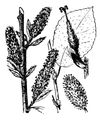580254 Salix myrsinifolia Salisb.
Distribution
Northern Iceland: Persistent (Adventive)
Northern Fennoscandia: Frequent
Shrub Tundra: Scattered
Bordering boreal or alpine areas: Frequent
- Salisb., Prodr. Stirp. Chap. Allerton: 394 (1796). - Nomen novum for Salix myrsinites Hoffm., Hist. Salic. Ill. 1, 4: 71 (1787), non L. (1753). Type (B?): Austria: "Carinthia Kärnten, Klagenfurth, an Fusse des Schmalzbergels", leg. F.X. Wulfen.
2n=
(1) 114 (6x). - Europe (N, C). - Numerous but mainly old reports for S. myrsinifolia (s. str.).
(2) 152 (8x). - Europe (N). - Marklund in Löve and Löve (1942b, for S. borealis).
Löve and Löve (1975a) listed several reports but the original sources should be checked as only a few of them are found under the relevant names in Fedorov (1969).
Not included: A fairly recent report of deviating numbers from central Europe is Büchler (1985, 2n = 77, 79, 80).
Geography: European: ICE* NOR RUS.
Notes: Skvortsov: This miraculously variable species [Salix myrsinifolia] opposes all efforts to subdivide it taxonomically. A lot of subspecific taxa have been proposed but in my experience they all are unconvincing. I believe its variability may best be studied along the lines of character (or gene) ecology and geography.
Elven: I am not satisfied with my own treatment of the Nordic variation (Elven and Karlsson 2000; Elven et al. 2005) as three races: subsp. myrsinifolia, subsp. borealis, and subsp. kolaënsis. There is some geographical patterns in sets of characters (e.g., flowering time, presence vs. absence of wax on the lower leaf surface, blade thickness and colour, pubescence of twigs, leaves, and gynoecia), but Skvortsov may well be right about gene ecology and geography rather than taxonomy as these characters are not always well correlated. If one ignores the inflated importance given by Enander and later by Floderus to glabrous vs. hairy gynoecia, the Fennoscandian material can be divided on four groups, two within my attempted concept of subsp. borealis. One problem is that we do not know much about the variation outside Fennoscandia and especially not about the Russian variation east of the Murman area and Karelia. Another problem is the absence of molecular and the scarcity of cytological investigations, here as elsewhere in arctic and boreal Salix. The proposed races are entered as subspecies as transitions seem to occur and as as all the reported variation only touches a small part of the Arctic (in Norway and northwestern European Russia).
Higher Taxa
- Salix [5802,genus]
